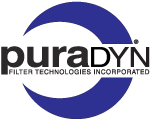Some of Our Most Frequently Asked Questions...Answered
No, the Puradyn System acts as a bypass, kidney loop, filtration system which keeps the engine running continuously on clean oil. It will not void your manufacturer warranty if properly used in conjunction with an oil analysis program.
Without factoring in increased efficiency or delaying an engine overhaul, it depends on the cost and man-hours of each oil change. For most larger engines, the Puradyn System pays for itself within 3–6 months.
Your OEM filter does not replace base additives and will not remove fluid contaminants. OEM filters only remove solids in the range of 5–15 microns while puraDYN filters remove solids down to < 1 micron.
No, Puradyn Systems work in conjunction with your OEM oil filters to protect your engine, and the OEM oil filter should be replaced at the same time as your Puradyn filter.
You should change the Puradyn filter element when you would have normally changed your engine oil and after an oil sample has been taken for analysis. All OEM filters should be replaced at the same time.
Yes, but we must know this information in advance. Diesel and natural gas lubricants use different additives, and the replacement filter additives are manufactured with the specific additives required for each application.
Yes, there is no issue at all with synthetics in an engine application. With EALs (especially in Hydraulic applications), we recommend having the specifications reviewed by Puradyn prior to usage.
Yes, assuming you conduct regular oil analysis and commit to following Puradyn’s Service Protocol during the trial period, Puradyn offers a six-month money-back guarantee, as well as a five-year unlimited miles/hours warranty on the unit.
